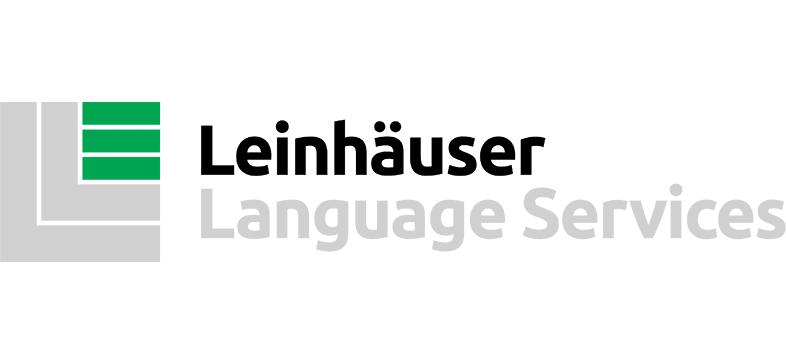Are you planning an international campaign?
Do you want your messages to reach an international audience?
To successfully roll out your campaign in multiple languages, your content must be tailored to each respective target market. At Leinhäuser, we adapt your texts and take into account cultural, linguistic and internal company requirements and instructions.
So far, so good. Of course, your colleagues in the target markets and specialist departments should also take a look at these adaptations.
They’ll want to approval certain terminology and pass on feedback from their own personal knowledge of the markets.
Here’s where it gets tricky: Although they have the necessary specialist knowledge of internal jargon and processes, they often lack the linguistic background to communicate these points effectively and eloquently.
That’s why any changes made by them should be cross-checked by language specialists before publication. In other words: Send the files back to the Leinhäuser team.
You can easily outsource feedback and approval management, which tends to be very time-consuming, and free up time in your calendar for tasks actually in your job description.
Customized solutions
We see ourselves as an extension of your team and are able to efficiently manage feedback loops for translations with your contacts in international markets or multilingual specialist departments – with customized solutions for your feedback management that meet the needs of your company and your target markets.
We’ll put together a technical setup adapted to your specific needs. With this in place, we can work efficiently and accurately while continuously improving the quality of our translations.
Now, let’s dig deeper into how this process works.
It all starts with the translation
As soon as it’s time to get to work on the multilingual assets, our experienced linguists start the careful process of translating your texts into one or more target languages and, if necessary, adapting them according to the cultural characteristics of your target markets, always following the tried-and-tested dual-control principle and making individual adjustments as required.
Once the target-language version is ready, you can pass it on to your contacts in the local markets or in departments responsible for the content covered in the piece, giving them the opportunity to provide feedback from their specialist perspective.
If you wish, your Leinhäuser account manager can take over coordinating this for you as well.
The traditional correction process
For a long time, we had only two standard options for making and communicating changes:
You could work directly in the target format while proofreading the target text. But because in this scenario you don’t usually compare the text with the source text, some changes may deviate slightly from the original meaning.
On top of that, you can’t easily access terminology guidelines, and if you have any questions about terms, you’ll have to look through a separate list.
And don’t underestimate the effort involved in post-processing if the corrections are to be taken into account for coinciding or future jobs.
Proofreading a bilingual Word file, something that we provide to you as an export file from our translation interface, reduces the chance of making inadvertent changes to the intended meaning of the source text. Still, there’s no easy way to compare it with terminology guidelines and glossaries.
However, post-processing is somewhat less time-consuming than when proofreading a standalone target text, and it doesn’t impact the format. It is therefore also suitable for exports from publishing or CMS systems and websites (e.g., csv, html, xml, xliff, idml, etc.)
We export these and other file types into the bilingual docx export format at the touch of a button after transferring them into the target language.
The browser-based correction process
There’s also another method for making corrections in an environment not influenced by formatting: working in a browser-based tool, specifically the online editor function.
This GroupShare functionality of the Trados translation interface offers significant advantages. Not only can you easily access translation memories (TM) and terminology that can be directly integrated into the interface, but you’ll also be able to work in a bilingual format.
Once we have translated the text into the target language in our translation interface, you can make your adjustments in the editor tool that you access in your browser – and you can also invite your colleagues with the specialist knowledge to join in. All corrections are updated in real time and are seamlessly available for subsequent or parallel projects.
By taking this approach, we can adapt to your preferences without compromising on quality.
Feedback loop
TM maintenance and delivery
We carefully maintain your translation memories and ensure that your target-language texts remain consistent and effective. In theory, all approaches offer the possibility to transfer approved versions to a TM in order to make them usable for ongoing and follow-up projects.
However, the effort involved varies. Entering corrections made to a standalone target text is the most costly and time-consuming model, closely followed by TM updating according to the corrections in a bilingual Word file.
When proofreading in the Trados GroupShare online editor, however, your translation memories are maintained seamlessly and without skipping a beat.
Once all change requests have been incorporated and there are no more outstanding questions from your teams or our linguists, your Leinhäuser account manager will send you the finished target-language version in the original format via your preferred delivery channel.
A partner for all (feedback) walks of life
As you can see, feedback isn’t a one-way street. We rely on your input to ensure that your texts exactly meet your expectations and have the desired effect. The easiest way to do this is with our online editor.
It simplifies the entire process from the first target-language version to the final approval. Thanks to a user-friendly interface, you can manage your feedback seamlessly and intuitively without having to deal with complex technical processes.
At the same time, you can rely on quick reactions, and we can implement your changes precisely to produce a high-quality result.








